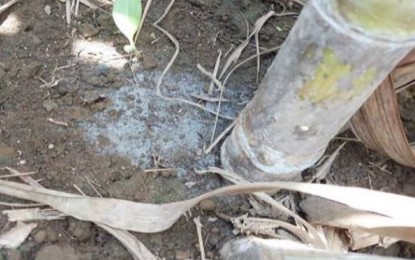
ASHFALL ON CANEFIELD. Volcanic ashfall monitored at the sugarcane experimental field of the Sugar Regulatory Administration-La Granja Agricultural Research and Extension Center in La Carlota City, Negros Occidental, on Tuesday (June 4, 2024). Testing detected increased acidity in the sugarcane fields of Negros Occidental affected by the ashfall from Mt. Kanlaon. (Photo courtesy of Sugar Regulatory Administration)
BACOLOD CITY – Testing detected increased acidity in the sugarcane fields of Negros Occidental, affected by the ashfall caused by the eruption of Mt. Kanlaon Monday night, the Sugar Regulatory Administration (SRA) said in a report on Wednesday.
Testing at the SRA-La Granja Agricultural Research and Extension Center in La Carlota City showed a 4.14 pH on sugarcane leaves and a 5.06 pH in the soil the morning after the ashfall.
Both results show increased acidity compared to a 6.48 pH outcome during ground testing last week.
In a statement, SRA chief Pablo Luis Azcona said the 6.48 pH result should have been ideal based on the neutral pH level of 7.
“Years of tilling sugarcane fields have affected our soil. As of now, it is too early to tell whether the volcanic ash will cause so much damage to crops. It has been raining on the affected places, and we hope the acidity will be diluted,” he said.
He said, "If it will not be washed out by rains, we will need soil rejuvenation in affected sugar lands to bring it back to the ideal state."
SRA records showed about 23,000 hectares of sugarcane fields in four sugar mill districts may have been affected by the volcanic eruption.
“We will continue to monitor pH recovery and what needs to be done. We have assigned field personnel, with SRA Board Member David Sanson, to go around affected areas and coordinate with the farmers,” Azcona said.
Based on the report of the SRA research team, the immediate effects of volcanic ash can cause physical damage to the leaves, reducing their photosynthesis capability and biological and chemical disruption on the soil, which can all lead to yield reduction.
“Its long-term effects on sugar crops can cause nutrient imbalance on soil, compaction and erosion and chemical leaching that may reduce the soil pH level,” it said.
It also said “volcanic eruption cannot be ignored as there have been records that it can adversely affect agricultural productivity,” citing examples such as the 1991 eruption of Mt. Pinatubo and the 2010 eruption of Eyjafjallajökull in Iceland that “disrupted sugarcane farming in parts of Europe due to ash fallout and subsequent atmospheric changes.”
As mitigating measures, the SRA research team recommended using cover crops, irrigation by washing off plants and soil, and applying lime or organic matter to neutralize soil pH changes caused by the ash fall.
“In the long run, though, sugar farmers can benefit in due time from volcanic ash fall as it is rich in minerals and nutrients such as potassium, phosphorus, and trace elements, which can enhance soil fertility over time and improve crop yields,” it said. (PNA)
